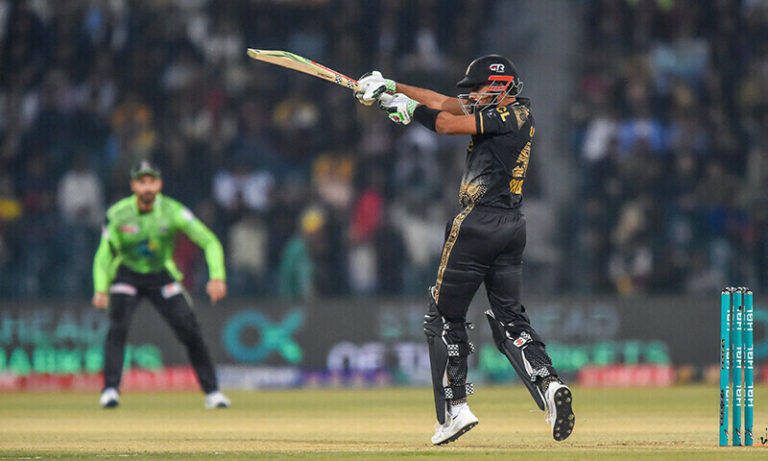• Study on how climate is affecting international cricket reveals half of all PSL 2025 matches were played in conditions meriting ‘Caution’ or ‘Extreme Caution’ on the heat index
• ICC not a signatory to UN Sports for Climate Framework, but Cricket Australia and ECB implementing heat policy guidelines, sustainability strategies
KARACHI: The Pakistan Super League has overcome several barriers to become the country’s most lucrative cricket product. But it will not escape the effects of climate change.
Experts have warned that rising global temperatures will impact future editions of the PSL, at least if it is scheduled in the same time as the last one.
Findings from Hit for Six: The Danger Zone, a report compiled by the British Association for Sustainability in Sport (BASIS) and other organisations, show that 17 out of 34 matches of the last edition of the PSL were played in conditions that could, at the very least, result in heat-related fatigue.
The first nine of editions of the PSL were held between February and March, but with Pakistan hosting the Champions Trophy this year, the glitzy T20 event was moved to the summer months of April and May, making it clash with the Indian Premier League.
The brief India-Pakistan skirmishes in May halted the PSL, eventually forcing it deeper into the summer once it restarted.
Initially due to climax on May 18, the season eventually ended a week later on May 25, and next year’s edition is likely to be held in the same time period.
“Estimates show that out of the 34 PSL matches played in 2025, half were played in conditions classified as either meriting ‘Caution’ or ‘Extreme Caution’ on the Heat Index — a measure that combines air temperature and humidity to assess heat-related risk,” said the findings shared with Dawn.
There were 15 days of ‘Caution’ and two days of ‘Extreme Caution’ — including the playoff between eventual champions Lahore Qalandars and Islamabad United.
According to the Heat Index, conditions meriting ‘Caution’ can result in fatigue due to prolonged exposure, while the impact of playing in ‘Extreme Caution’ conditions can lead to sunstroke, muscle cramps or possibly heat exhaustion.
“From match 27 [on May 17] onwards, all matches (including the playoffs) were played under conditions that met the ‘Caution’ or ‘Extreme Caution’ parameters of the Heat Index,” the findings of the report add.
March ‘not an option’
However, the report says that going back to March won’t be an option as the global climate shifts.
“Whilst PSL matches avoided conditions that fell inside the ‘Danger’ categorisation, as the report outlines, rising global temperatures will continue to make weather events like last year’s 50 degree temperatures increasingly likely, with extremes of heat like the 2022 March heatwave over 30 times more likely because of climate change,” it says.
While cricket may not be the most physically intense game, it is among the longest, with 50-over matches lasting up to eight hours. The intense weather conditions mean direct exposure to the sun for long hours.
T20 is the game’s shortest format, but the report’s findings mean it will also have to be played while keeping the climate in mind.
“Like many aspects of our lives and communities, climate change may necessitate changes in cricket in the future as the planet warms,” Dr Kristina Dahl, the vice-president of Climate Central, one of the organisations involved with the study, told Dawn.
“It is dangerous to both players and fans to hold matches when it is extremely hot and humid, so the sport could consider options like holding matches during times of the day or times of the year when it tends to be cooler, or gameplay could be moved to indoor stadiums that can be air conditioned.
“The countries around the world where cricket is typically played tend to be hot places, so the PSL won’t be the only league facing these challenges.”
The proliferation of T20 leagues around the world, which have become financial drivers for their cricketing boards, means a balance has to be found. The carbon footprint of these leagues — emissions from travel, stadium operations, and other activities — remains unknown.
“Carbon pollution is carbon pollution no matter who emits it and where, so the more we can do to reduce personal, institutional, national, and international carbon pollution, the less warming we’ll experience in the future,” adds Dr Dahl. “And the less warming we see, the less disruption we’ll have to sports like cricket.”
Problems across the border
Across the border, the Indian Premier League faces even greater climate danger. Unlike the PSL, it has marked a permanent place in the calendar between March and May.
“More than 36pc of 2025 IPL games took place under ‘Extreme Caution’ conditions, where heat exhaustion becomes a serious threat, with a further 12pc reaching a ‘Danger’ classification where the risk of heatstroke becomes significant,” the report states.
While the International Cricket Council isn’t yet a signatory to the UN Sports for Climate Framework, Cricket Australia and the England and Wales Cricket Board have been active in implementing new heat policy guidelines and planning sustainability strategies.
Dr Dahl believes more directions from world cricket’s governing body to its members on how to better deal with the impact of climate change. “Measures put in place for players and fans would help to protect them both now and in a warmer future,” she said.
“If, for example, there was a heat index threshold or an air quality threshold above which matches were postponed or cancelled, the number of events that were affected might be small today, but larger in the future as extreme heat conditions become more frequent. But having those measures in place now would prepare the sport for further warming in the years ahead.”
Published in Dawn, July 22nd, 2025

